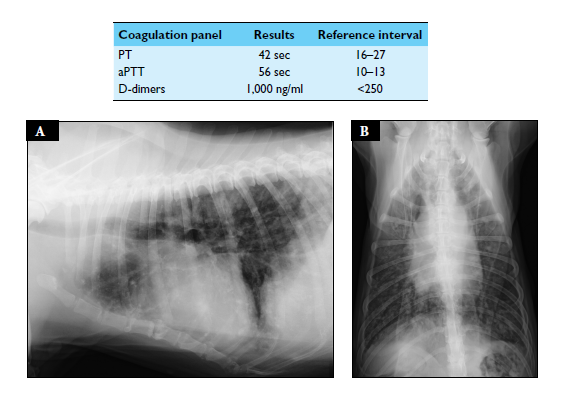Difference between revisions of "Canine Infectious Diseases: Self-Assessment Color Review, Q&A 07"
Jump to navigation
Jump to search
(No difference)
| |
Latest revision as of 09:43, 26 November 2018
| This question was provided by CRC Press. See more case-based flashcards |

|
Student tip: This case is a scenario with good radiograph imagery |
Case 07 is the same dog as in Case 06. Thoracic radiographs (A, B), CBC, serum biochemistry analysis, urinalysis, and a coagulation profile were performed. The CBC showed only mild eosinophilia. Serum biochemistry analysis and urinalysis detected no abnormalities. The coagulation profile revealed the data in the above table.
| Question | Answer | Article | |
| What is your assessment of the diagnostic test results? | The thoracic radiographs reveal a severe bronchointerstitial lung pattern with micronodular infiltrates. This could be seen with neoplasia, infectious diseases (especially fungal or parasitic diseases), or inflammatory disorders such as eosinophilic bronchopneumopathy. The peripheral eosinophilia could be seen with parasitic infection as well as in hypersensitivity disorders and is commonly found in dogs with eosinophilic bronchopneumopathy. The combination of increased PT and aPTT and increased D-dimers suggests consumption of coagulation factors due to DIC. The two pulmonary diseases that are most likely to be associated with coagulation abnormalities in dogs from this region are infection with the parasite Angiostrongylus vasorum and a neoplastic process.
|
Link to Article | |
| What additional diagnostic work-up would you suggest? | Diagnosis of A. vasorum infection requires collection of a fecal specimen on three consecutive days for analysis using the Baermann technique. Alternatively, larvae sometimes can be detected microscopically in bronchoalveolar lavage fluid. Measurement of antigen using ELISA on serum and detection of the organism in whole blood using real-time PCR can also be used for diagnosis. If there is no evidence of infection with either of these diagnostic methods, diagnosis should focus on neoplastic disease (usually through bronchoalveolar lavage or fine needle aspiration of the lung). Given the presence of a micronodular lung pattern, which suggests metastatic neoplasia, a search for a primary tumor in another location would also be indicated.
|
Link to Article | |
To purchase the full text with your 20% discount, go to the CRC Press Veterinary website and use code VET18.
